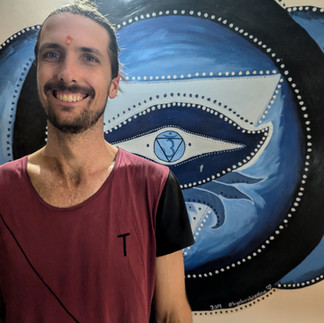
Yin Yoga Teacher Training
- meleaapps
- Dec 14, 2024
- 5 min read
“Yin Yoga, when taught skilfully, can provide this opportunity to go within and re-align our orientation.”
~ Sarah Powers
“To be soft and flexible is the way of life.”
~ Lao Tzu
I was in Rishikesh in 2017 to complete my 200-hour Yoga Teacher Training at the Association of Yoga and Meditation, I always thought I’d be back to complete another 300 hours at some point. Life had a different plan and as Yin Yoga was a huge draw card for further learning I opted for this 50-hour deep dive through the Rishikesh Association for Yoga. Rishikesh is located at the foothills of the Indian Himalaya in the state of Uttarakhand and is believed to be the birthplace of yoga. It’s built either side of the Ganges river, otherwise known as Mother Ganga Ji. Descending from the mountains, the water is crisp, clear, fast flowing, refreshing and super special to be close to and swim in. I am grateful that I have had/created the opportunity to learn yoga here. All of our teachers imparted such inspired and embodied wisdom, it was an utter joy and privileged to learn from them.

At the start, learning yoga in India was completely personal, to deepen my own practise and understanding of its roots. The last few years as I have been teaching more regularly I’ve found a new love for sharing this amazing practise. I am excited to offer more Yin classes upon return to Australia.
.
Yin yoga is where Yoga & Daoism meet, such a special new world to explore as two of my passions merge. Yin yoga and many other forms are born from Hatha yoga in India dating back 1000 years, which originated from Classical or Tantra Yoga 2000 years ago. The oldest spiritual texts in India speak of the purpose of yoga being liberation, disclipline and being able to sit still in meditation, which in fact is Yin in nature (Clark, 2012). Many of the styles of yoga or movement we practise today in the west are Yang in nature: dynamic, warming, active, expansive. Yin, which is cool, internal, slow and nourishing in nature is important to practise in a world that moves so quickly. The asanas in this practise are held for 3-15 minutes, which allows access to the deeper parts of the body. Through this practise we exercise the joints, ligaments, fascia network and even bones.
.
However this kind of movement practice is not only found in ancient India. Dao Yin dates back to 2146BC in China and was used as a foundation for martial arts training. This combination of physical movements, breath and mental focus was a key component of health and spiritual cultivation (Chen, et al. 2019). Where Qi Gong is about the nourishment and circulation of Qi throughout the meridians/channels of the body, Dao Yin is about purging toxins and ‘evil Qi’ through stretching the sinew channels. This practice of long held positions is said to tease open joints and lengthen the tissues, including muscle, fascia and tendons (Lotus Nei Gong, 2023).

The Yin Yoga we know today, and the one we learnt in Rishikesh was brought to the West in the 1970’s. Paulie Zink was a champion martial artist who began teaching animalistic movements to balance Yin and Yang in the body. A student of Zink’s Paul Grilley combined the teachings he was learning with Chinese channel theory and Hatha yoga to create Yin Yoga. Sarah Powers and Bernie Clark are also original and leading teachers of Yin Yoga in the West.
.
In the course we started each day at 6:30am with Ankit for an hour of pranayama, learning theory about prana, the body and then practise. We explored yogic breathing, Nadi shodhana, ujjyi and bhramari. Next we had Yin Asana for 90mins with Ganesh where we learnt the 26 yin postures, talked about variations, injury and the use of props.
.
After lunch we had 3 back-to-back classes. First up was Yin philosophy with Mukti where we discussed the Daoist roots and theories such as Yin Yang and Wu Xing (Five Elements). Our teacher was adept in Ayurveda and Yogic Philosophy and I was amazed at how many similarities exist within these ancient systems for healthcare. She was a wealth of knowledge, loved reading books and research articles and was a joy to learn from.
.
The next class was Yin Anatomy with Anand where we covered the meridian pathways and touched upon some Traditional Chinese Medicine theory. A lot of this was known/familiar for me but it was great to revise and I certainly learnt a lot too. The majority of our days were spent on the floor on the yoga mats, which was a challenge in itself, I haven’t felt that embodied in a long time. After that we had Yin Sequencing where for the first few days our teacher Ganesh taught us a Yin class so we could really drop into the practise, the last few sessions involved more discussion of how to sequence classes well.
Lunch was next and then a few hours down time before our Yang class in the afternoon with Gaurav. It was awesome to mix it up and the hatha based classes were challenging mentally and physically. I learnt A LOT and was stoked to try a new asana - the peacock. Gaurav was an amazing teacher and worked to complement what we had practised earlier in the day. Over the 5 days we deep dived into arm balances, inversions, back bends and forward bends.
.
Finishing the day with a Yoga Nidra class was incredible, we covered the theory on the first day and then were able to lie down and soak up this beautiful practise for the rest of the course. If you’ve never experienced it before I highly recommend looking it up on YouTube or Spotify - such a nourishing meditation to build somatic awareness and presence. Wonderful before bed or if you struggle with sleep issues.
The long days ended at 7pm for dinner. We ate well over the five days, simple satvic, vegan food that varied daily.
It’s very profound to be immersed in ancient tradition, opening and closing ritual and ceremony, and learning from original roots. I had an intense and beautiful moment of gratitude that brought me to tears one savasana, recognising the journey that I’ve been on this year. How special it has been to learn in both China and India from incredible teachers who have this knowledge in their DNA, lifetime commitment of study and practise.
REFERENCE LIST
Chen, X., Cui, J., Li, R., Norton, R., Park, J., Kong, J., & Yeung, A. (2019). Dao Yin (a.k.a. Qigong): Origin, Development, Potential Mechanisms, and Clinical Applications. Evidence-Based Complementary and Alternative Medicine. Volume 2019, Issue 1.
Clark, B. (2012). The complete guide to yin yoga, the philosophy of practice of yin yoga. White cloud press. United States.
%20(1).jpg)

































Comments